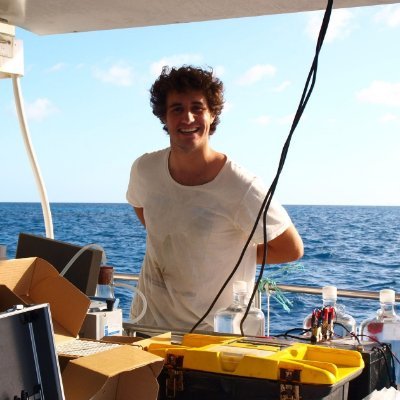
Lennart Bach
@bach_lennart
Followers
996
Following
3K
Media
209
Statuses
2K
Marine Biogeochemist, Global Citizen, Dude // Investigating consequences of, and solutions for, the climate crisis // Based at @IMASUTAS 🇦🇺
Hobart, Tasmania
Joined July 2018
A new update on our Ocean Alkalinity Enhancement study in Tasmania posted on bluesky.
0
0
0
Some impressions of day 1 can be seen in this short video. https://t.co/i0CaC1M2yE
0
2
1
On day 1 of the Ocean Alkalinity enhancement field study in Tasmania we scouted the study site, tested equipment how ground rock can be added to the sediment in the best way (a surprisingly challenging task!) 🌊 Blog 2 👇 https://t.co/6yooFmnMlG
1
2
2
Context, motivation, and goals of the OAE field study is provided in a ~12 min presentation https://t.co/kMScsavG4W
0
1
3
We initiated a small-scale field study on Ocean Alkalinity Enhancement in Tasmania. Over the next months we will provide updates on how the study evolves. We aim to provide robust/ independent evidence if OAE could work and is sustainable. Blog 1 👇 https://t.co/rKlh3pDmVK
1
1
9
Does being an applied marine biogeochemist also make you a better player in CO2 removal monopoly? The students had not a chance 🤩
2
2
13
The effect of rain on air-water gas exchange and CO₂ fluxes is a topic I started researching 30 years ago. I’m really pleased to see our latest paper — showing that rain enhances ocean CO₂ uptake — finally in print.
Article: About 6% of the total uptake of carbon dioxide by the ocean is due to rainfall @Geosciences_ENS @IPSL_outreach @CNRS_INSU @CNRSIdFSud @CNRS @laurent_bopp @_david_ho_
https://t.co/zLQteVoe9c
3
16
52
Can dumping seaweed on the sea floor cool the planet? Some scientists are skeptical | Science | AAAS https://t.co/P0Andans7D
science.org
“I think it’s nonsense,” one expert says
0
6
7
The #OAEPIIP website can be found here: https://t.co/7xoXChE19Q
0
0
0
Participants (or interested readers) please also check our Github page for useful resources on how to set up #OAE carbonate chemistry and how to evaluate #OAEPIIP data statistically. https://t.co/shzDq6XyiU
github.com
OAEPIIP. Contribute to OAEPIIP/OAEPIIP development by creating an account on GitHub.
1
0
0
Update on #OAEPIIP The final version of the technical note paper (explaining the OAEPIIP experiment) is now published. https://t.co/H3h8t0RUYT
bg.copernicus.org
Abstract. Ocean alkalinity enhancement (OAE) aims to transfer carbon dioxide (CO2) from the atmosphere to the ocean by increasing the capacity of seawater to store CO2. The potential effects of...
1
4
8
"Climate disinformation" is an elitist trap. Why? It centers the professional-managerial class in climate action — people who work with information — rather than people who build goods and grow stuff. https://t.co/1OfvSLKqgE
jacobin.com
Much of the climate movement is now pouring its energies into combating disinformation. But this focus fails to address real concerns about a green transition and obscures what is needed to win the...
55
113
604
Question to @cdr_fyi: The database lists one of the biggest seller for durable CDR as "Not Disclosed" ( name and CDR method). Is that one singular seller or all the small sellers collectively? Surprising to see such a big volume without transparency provided by the seller.
1
1
0
Our new paper is out from @Nature! It shows that the contribution of preformed nutrients of Southern Ocean origin to low-latitude ocean production and export is more limited than previously thought. Please check it out!!
nature.com
Nature - To facilitate more accurate long-term projections of primary production and export over oceanic low latitudes (LLs), we identified the first-order importance of the temperature dependence...
1
25
47
Land carbon sinks are included in Nationally Determined Contributions (NDCs) but ocean sinks aren't. Should they be? No, for several reasons including additionally, equity, and difficulty of MRV (#CDR intervention, carbon uptake, and storage could be in different places).
3
8
21
🚨 ONE WEEK TO GO! Don't miss out on being part of the fascinating line-up of events at the Australian #Antarctic Research Conference: 🎙️10-minute presentations 📉 Posters ⚡️ Lightning talks 🧑🤝🧑 Side events ➡️ Submit your proposals by 𝟭𝟮 𝗔𝘂𝗴𝘂𝘀𝘁 at https://t.co/e9zsGTUIur
0
9
15
Another recent paper by @C_Moras12 that just got published showed the "Effects of grain size and seawater salinity on magnesium hydroxide dissolution and secondary calcium carbonate precipitation kinetics: implications for ocean alkalinity enhancement"
bg.copernicus.org
Abstract. Understanding the impacts that mineral grain size and seawater salinity have on magnesium hydroxide (Mg(OH)2) dissolution and secondary calcium carbonate (CaCO3) precipitation is critical...
0
3
7
I missed to retweet this paper led by @C_Moras12 about the potential of steel and iron slag for Ocean Alkalinity Enhancement #OAE. Some slag is quite effective, more than other minerals that can be found "in the wild".
/!\ New research out (full text soon), where we looked at the suitability of iron and steel slag for #OAE. Surprisingly, steel slag had an unexpected high cumulative CO2 capture potential of 10-22 Gigatonnes by 2100! @FrontiersIn @bach_lennart @tcyronak
1
1
3










